In Mexico, SEL is both a pressing need and a legal mandate, yet educators aren’t equipped with the mindsets, skills or training to implement it. We created EW to build educators’ and leaders’ social-emotional skills as a goal in itself, and to empower them to teach those skills, embed SEL in school culture and across their communities—supporting student wellbeing and driving systemic change.
Educating for Wellbeing (EW) consists of three core components that guide participants and school systems from initial SEL awareness to sustainable, systemic implementation.
(I) SEL Professional Development: Educators complete a 120-hour blended program—through live (in-person or Zoom) sessions, a self-paced online course, and a mobile app—to explore, embody, and apply SEL competencies in their personal and professional lives, enhancing their well-being.
(II) Student SEL Curriculum: Siconautas (Psychonauts) is a comprehensive, age-appropriate curriculum with student and teacher manuals and classroom materials. It equips educators to teach and model SEL skills through direct instruction and daily classroom routines.
(II) Leadership Training for Systemic SEL Implementation: Educators in formal or informal leadership roles undergo an 80–200-hour process to organize, implement, and evaluate SEL strategies. With coaching support, they adapt and sustain culturally relevant, systemic approaches.
Through this process, teachers, principals, and other school staff develop SEL competencies while building safe and supportive learning environments and effectively teaching SEL. A subset of leaders is trained in whole-school implementation for students and adults, including parents. Each year, new educator cohorts are mentored by trained leaders and peers. The process is repeated until a majority of educators in a region are trained.
After five years collaborating with educators across Mexico—facilitating workshops and co-creating the national SEL framework and curricula—Educating for Wellbeing (EW) launched in 2018 as Mexico’s first scalable, evidence-based SEL professional development program, starting with 900 preschool educators in seven states.
In 2019, EW added a systemic leadership component—piloted in Campeche—and introduced the first version of a student workbook. That year, 2,451 educators across six states participated.
From 2020 to 2023, EW expanded to nine additional states and extended its scope from preschool to K–12. Around 37,000 educators and 400,000+ students benefited. The Siconautas SEL curriculum was developed for pre-K through 3rd grade.
In 2024, EW introduced coaching for sustainable SEL implementation, starting with 100+ education leaders from Campeche, Yucatán, and Quintana Roo.
To date, nearly 50,000 educators in 16 states have engaged with EW, impacting over 4 million students in 25,000 schools. EW has achieved multi-year, systemic implementation in at least three states and partnered with educational authorities in over half of Mexico’s states, with a focus on vulnerable communities, including Maya-speaking regions of the Yucatán Peninsula.
Scalability has been strengthened through a growing facilitator network—from 60 to 180 certified instructors in four years—enabling flexible, hybrid and fully virtual delivery in partnership with local Ministries of Education.
To adapt to different contexts while maintaining consistency and quality, we developed a structured implementation framework that identifies when necessary and sufficient conditions are in place and allows quick adaptation to changing circumstances while ensuring delivery.
We also developed a real-time monitoring system that enables timely implementation adjustments. This data can be shared with education authorities to sustain teacher adherence and support collaborative decision-making. The system links directly to our communication strategies—email and WhatsApp—for personalized follow-up with participants.
To support leaders post-training, we developed a 120-hour Systemic Coaching follow-up, monitoring and coaching schools as they implement and integrate new educators into SEL. This includes additional classroom curriculum workshops and in-person school visits.
Our Psychonauts (Siconautas) curriculum is fully developed through Grade 3, expanding to Grade 6 in two years and to Grade 12 in five years.
We have learned to work with education authorities and funders to deploy the program on flexible timelines, at various times of the year, and with different levels of hybridization, based on the needs of each state's educational ecosystem.
We have recently introduced teacher-based student assessments in all our implementations and piloted classroom observations with CLASS®. We are also conducting third-party qualitative research on EW.
Interested in implementing EW to strengthen your school community and educate for (and from) wellbeing?
We would be honored to work with you to adapt EW to your local context and maximize its impact. Please reach out to our Director at daniela@atentamente.mx.
We are also seeking partners to help expand and fund our work in Mexico and beyond. If you’re interested in supporting our mission, we’d love to hear from you.
Together, we can empower more educators, create nurturing learning environments, and embed SEL across education systems.
Please try our webpage atentamente.mx and our RSS for more information and free access to some of our material. Our free mobile app is also a great resource to start, on Android and IOS: AtentaMente Meditación y Felicidad.


